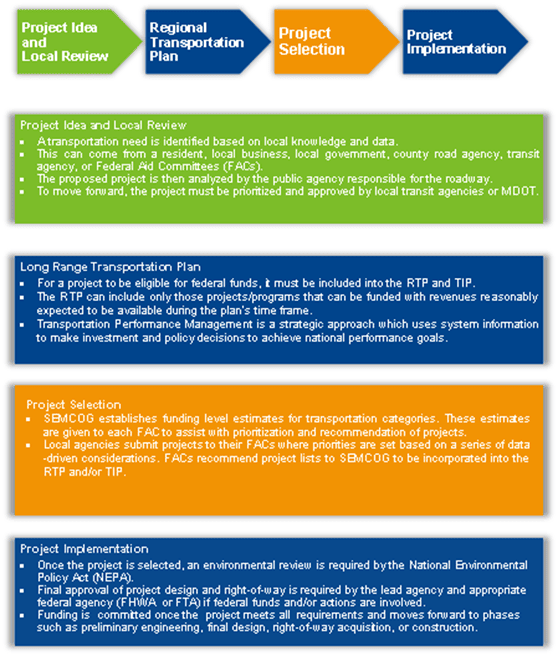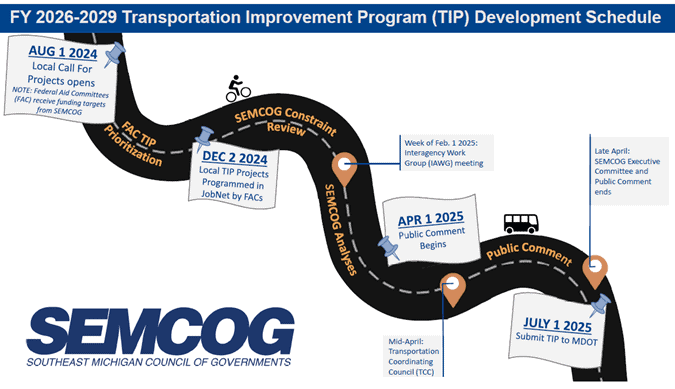SEMCOG’s Transportation Improvement Program (TIP) is a short-term list of road and transit projects that prioritize funding for cities, villages, county road agencies, transit agencies, and Michigan Department of Transportation (MDOT). The current FY 2023-2026 TIP describes how over $6.2 billion will be invested to support the regional transportation system. The TIP is guided by the policies outlined in the Regional Transportation Plan (RTP). The next edition of the RTP, Vision 2050 is on track to be adopted by the General Assembly on June 27, 2024.
The TIP is a four-year program for road and transit projects. Projects are recommended by the Federal Aid Committees through local coordination and prioritization meetings. FAC Meetings occur on a minimum semiannual basis. See the SEMCOG FAC webpage for meeting information, resources and contacts.
TIP Projects can be amended to add, change, or delete projects to meet changing priorities or to take advantage of additional funding sources over the life of the program. Amendments to the TIP must undergo the same public review as the original TIP, while SEMCOG’s Executive Committee makes the final approval of the TIP project list.
SEMCOG is preparing the FY 2026-2029 TIP. See the development schedule below.
How Are Decisions Made?
Implementation of transportation projects follows a data-driven and inclusive process. Guided by the RTP and local road and transit priorities, the following components support decisions for future investments:
- Data: Population, employment, freight movement, traffic safety, road and bridge conditions, land use, and traffic flow trends are researched and analyzed.
- Input: Public participation opportunities are part of the entire planning process (public meetings, surveys, and comment periods). Public input is used to assist in identifying the goals, visions, opportunities, and needs of the region.
- Funding: Adequate available funding is necessary to maintain and improve the transportation system.
These components develop a vision outlined by RTP and ultimately leads to a slate of projects to be implemented by the road and transit partners in the region.

Nearly all projects in SEMCOG’s TIP receive some sort of federal funding, typically an 80% federal/20% local split. Before a transportation project can receive federal funds, project sponsors must complete several steps to ensure the money is being well spent. Each step presents an opportunity for citizen involvement – for your voice to be heard.
SEMCOG ensures that existing and future expenditures of government funds for transportation projects and programs are based on a continuing, cooperative, and comprehensive (“3-C”) planning process.
More information is available in the SEMCOG Guide to Transportation Planning.
Summary of FY 2026-2029 TIP Development
As a regional planning organization, SEMCOG understands that local residents and local governments know their unique transportation networks best. To support local decision-making, SEMCOG works closely with Federal-Aid Committees (FACs) throughout project development and the selection process for roads eligible to receive federal funding. FACs are an essential part of developing and implementing the RTP.
There is an FAC for each of SEMCOG’s seven counties as well as the City of Detroit. Committee members for each FAC include city, county, township, and village officials; transit agencies; county and city planners and engineers; and MDOT. FACs discuss and approve project recommendations and create a prioritized list of projects within the available funding.
SEMCOG has hosted meetings to coordinate with local road and transit partners about the schedule, project selection priorities, and important information to ensure that project are entered into the FY 2026-2029 TIP in a seamless manner.
Meeting #1: March 6, 2024
This kickoff to the FY 2026-2029 TIP Development featured conversation of Safety as a Priority in Project Selection and presented an introduction to the recent Infrastructure Coordination work at SEMCOG.
Meeting #2: May 23, 2024
At this meeting, the group took a deeper dive into best practices for project prioritization/selection and programming regarding safety, scoring, applications, mapping, etc. Staff from MDOT Local Agency Programs (LAP) presented updates to the website, forms, programs, contacts, and held a Q&A.
Next Steps
Projects for the FY 2026-2029 TIP must be programmed by December 1, 2024. SEMCOG will continue to work with FACs to develop a fiscally constrained list of projects to implement the priorities outlined in Vision 2050. The next meetings are planned for:
- Meeting #3: June 20, 2024
- Meeting #4: August 23, 2024


Leave a Reply